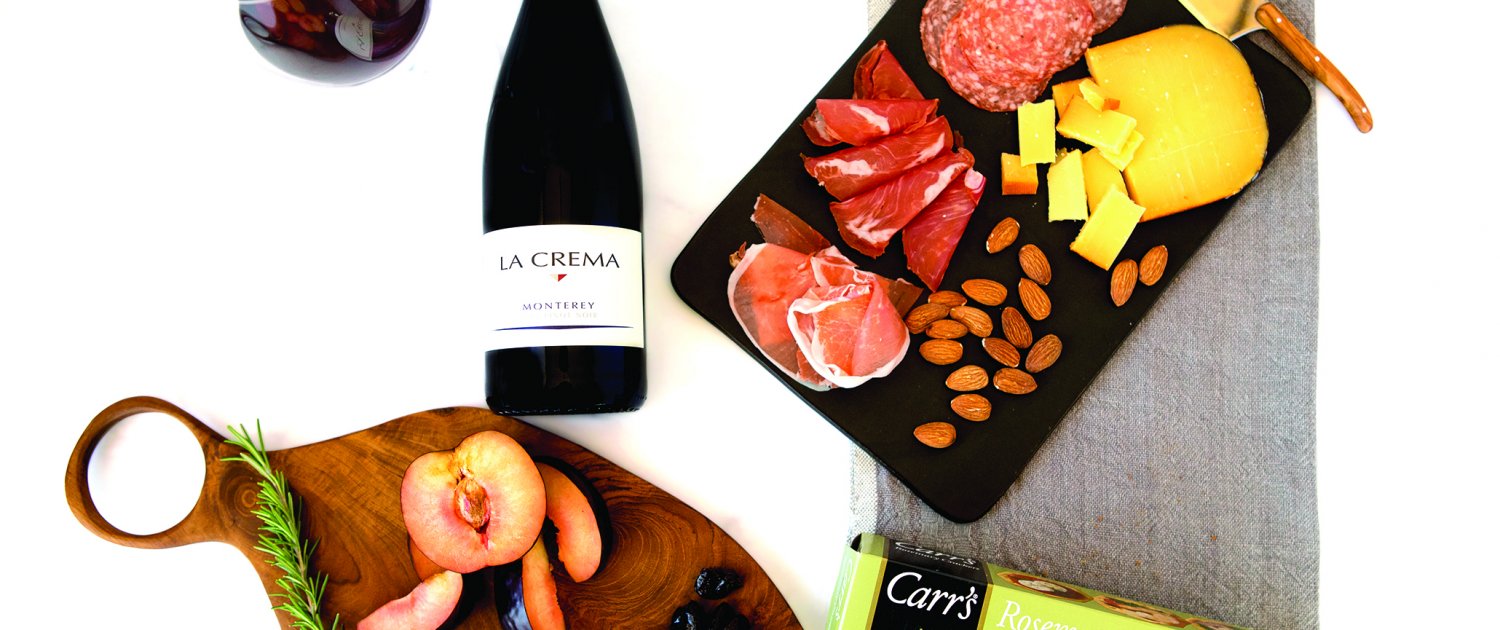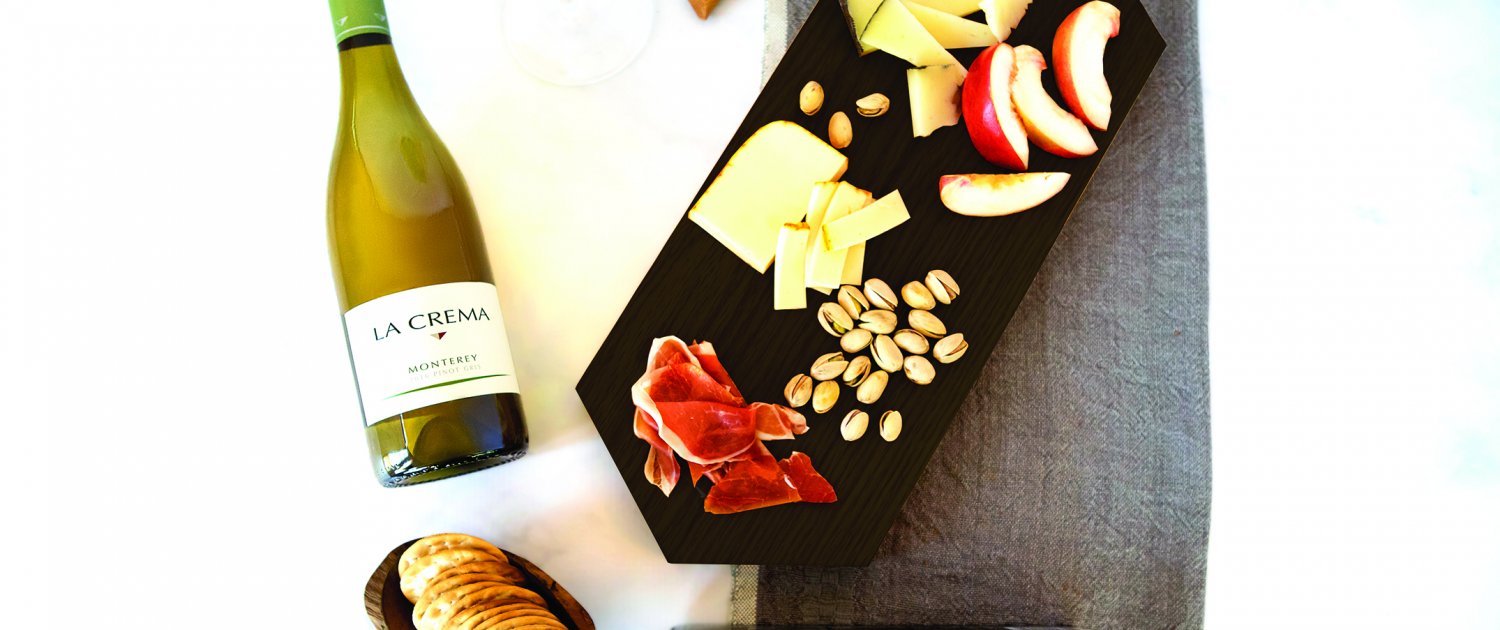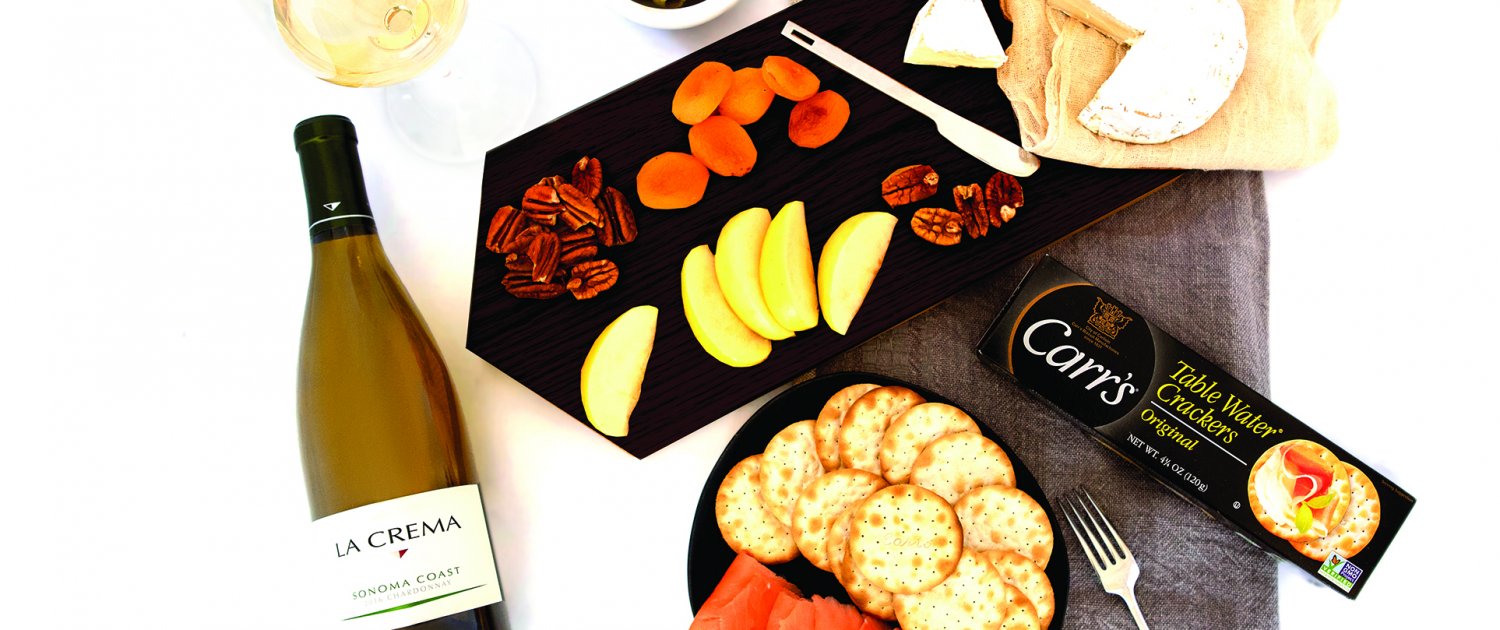
The Definitive Guide to Wine Country Cheese and Wine
Christy Canterbury, Master of Wine
People say, “Age doesn’t matter unless you’re cheese or wine.” So, now is as good as any time to delve into this hotbed of deliciousness if you’re curious to learn some of the principles of wine and cheese pairing!
Moreover, learning about pairing wine with cheese is incredibly easy to DIY. No cooking is necessary, and the clean-up is minimal. Lay out several cheeses and let them warm up from refrigerator temperatures to release their maximum flavors. Then, pour a few different wines into different glasses, and you’re ready to explore.
Once you’ve played around with the combinations of wines and cheeses on their own, get artsy! Add some charcuterie, smoked fish, olives, dried fruits, preserves, honey and nuts to the pairing possibilities and experiment with different breads and crackers. The sky is the limit!
BASELINE LEARNING AND UNLEARNING
Yes, there are classic wine and cheese pairings, like goat cheese with Sauvignon Blanc and blue cheese (and Stilton, in particular) with Port. However, within the broader categories of cheese, there are many different takes on a single style. Goat cheese, for example, can come soft, tartly fresh and plain; moderately firm and encrusted with herbs or cracked peppercorns; or aged until crunchy, crumbly and nutty.
As with anything in life, there are ideas that persist without having much – or any – basis. One cheese and wine pairing idea that falls into this camp in the USA is that red wine with cheese works best. This is fascinating when we look at the principles of non-cheese food and wine pairing. One of the first (overly simplified) tenants of wine and food pairing is color matching: white wine with fish and poultry but red wine with meat. So, how did we abandon this concept with cheese? The reality is that there is plenty of crossover between whites, rosés and reds and cheese.
Again, there’s nothing like doing something yourself to understand it. It may seem to go without saying, but be sure to pay attention when you taste. Otherwise, you’re not grasping the fundamentals of wine and cheese pairings; you’re just engaging in the motions and not fully taking in the experience.
REWIND – MILK TYPES
Let’s take a look at the base components of cheese to help in our understanding of cheese and wine pairings. There are four milk types, and on occasion, some are combined.
Cow’s Milk
It’s a bigger animal than the others, so it follows that it makes more milk. Most cheese is cow-based. It’s super versatile and usually has a yellow tinge, based on the beta carotene from the cows’ munching.
Goat’s Milk
A smaller and less fatty animal, the goat makes leaner cheeses. Mostly unaged in the USA, it’s not uncommon to see aged versions in France. Goats cheeses are characterized by their vibrant acidity, which gives them tanginess and helps them feel lighter. They are snow white in color as goats turn beta carotene into Vitamin A, rather than passing it through their system into their milk, like cows do.
Sheep’s Milk
This animal delivers the motherload of cheese fat. Have you ever noticed a cheese “sweating”? That’s probably a sheep milk cheese, that with ambient warmth, releases its fat content on its surface. Even aged sheep milk cheese tastes richer. (With aging, cheeses lose moisture, which usually make them crunchier and relatively lighter.) Sheep give less milk and cannot be machine milked, so we usually pay more for them.
Water Buffalo’s Milk
These creatures’ milk is even fattier than sheep milk! In fact, water buffalo milk is so proteinaceous that it’s not drinkable. (Multiply the texture of heavy cream by at least three.) This is the rarest cheese milk type due to the low yields.
PLAY – CHEESE CONSISTENCY
The texture of cheese varies dramatically. Even I noticed it when my upbringing encompassed primarily two “cheese” styles: shredded and Velveeta (a cheese product, not truly cheese). Like with the milk source, cheese consistency can contain a wide variety of styles within a broad category.
Fresh
Creamy and easily spreadable, these are young and unaged.
Soft
Still relatively inundated with moisture thanks to a very short aging period, these young cheeses have a gooey texture.
Semi-Soft or Semi-Firm
Aged longer than soft cheeses, these have more structure and tend to be good melting cheeses.
Firm
“Worked” more than the cheeses mentioned above, firm cheeses are also aged. Hence, as humans would be, they are a bit toughened (think more muscular). Also, the aging process reduces moisture, helping make them firmer.
Hard
This is a long-aged cheese with little moisture. This is the cheese style with the “crunchies”, where crystalline structures give these cheeses a new dimension of texture.
FAST-FORWARD – CHEESE PAIRING PRINCIPLES
Matching wine and cheese depends on many factors. Taste is the first and foremost consideration. If you like it, stick with it!
Additionally, not every artisanal cheese tastes the same in every season. Some cheeses are best when made from summer milk, and others are aged so long that it matters less. Have a chat with the cheesemonger at your local cheese shop or top-shelf grocer to see what’s most enticing when you are stocking up.
The most important principle to keep in mind is balance. Generally, the more generous the flavor of the cheese, the more generous the flavor the wine should be and vice versa. This also works with texture, acidity and alcohol. Pair like with like.
Or, if you want to be contrarian, delight in the phenomenon of opposites attracting. For example, connect a sharp cheddar with a big, rich red. Or, pair a salty blue cheese with a decadently sweet wine. It’s kind of like bringing the sweet-and-sour Chinese food concept for cheese and wine. Works like a charm.
Finally, there’s the old – and true – adage that “what grows together goes together”. This theory stipulates that if you pair a cheese and a wine that are produced near each other that they will likely work well as a pair. This is largely based on regional traditions and best applied to the “Old World” (that’s Europe in geeky wine speak), but it can work in the New World, too, especially when the ideas above are applied to the cheese and wine pairing.
Wine and Cheese Pairings
There are more edges of cheese rind to slice off, and this guide could go on about washed rind cheeses, alpine style cheeses, cheddar style cheeses and on and on…with wine pairings. But, by now, surely you’ve embraced the idea: exploring wine and cheese is as exciting and as confounding as the two individual products. To help wipe away any trepidation, we’ve taken the principles above and combined them into a few of our favorite pairing palettes for La Crema wines.
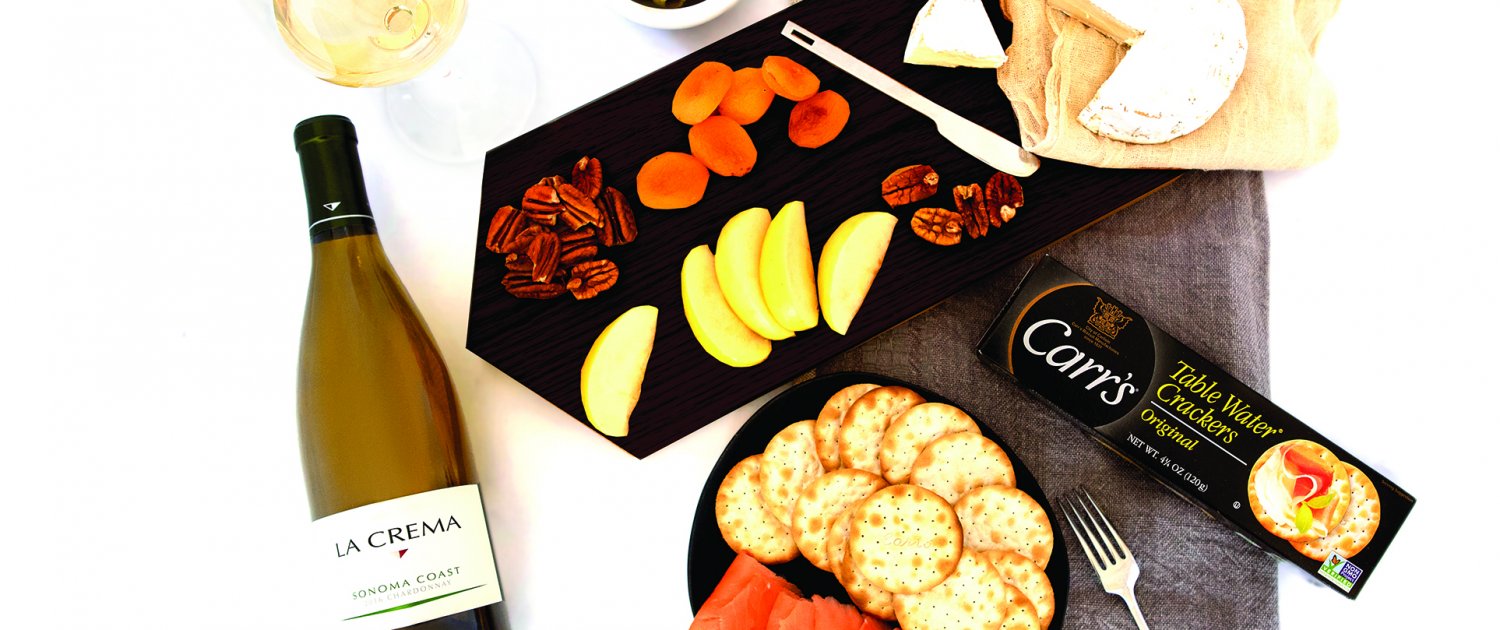
Sonoma Coast Chardonnay
Classic and Seamless
A classic cheese pairing for La Crema’s Sonoma Coast Chardonnay would be a lush, bloomy rind cheese like Brie or Camembert. Their seamlessly smooth textures echo each other. For textural contrast, add Carr’s Table Water Original Crackers and a crisp slice of light-skinned apple. Encourage the sweet cream flavors of the cheese to soar by incorporating dried fruits or honey-roasted nuts. Then, contrast the cheese with the saltiness of smoked salmon and olives.
Pair With:
- Brie or Camembert Cheese
- Carr’s® Table Water® Original Crackers
- Dry Cured Smoked Salmon
- Dried Stone Fruit
- Light Skinned Apples
- Spiced or Honey-Roasted Pecans
- Castelvetrano Olives
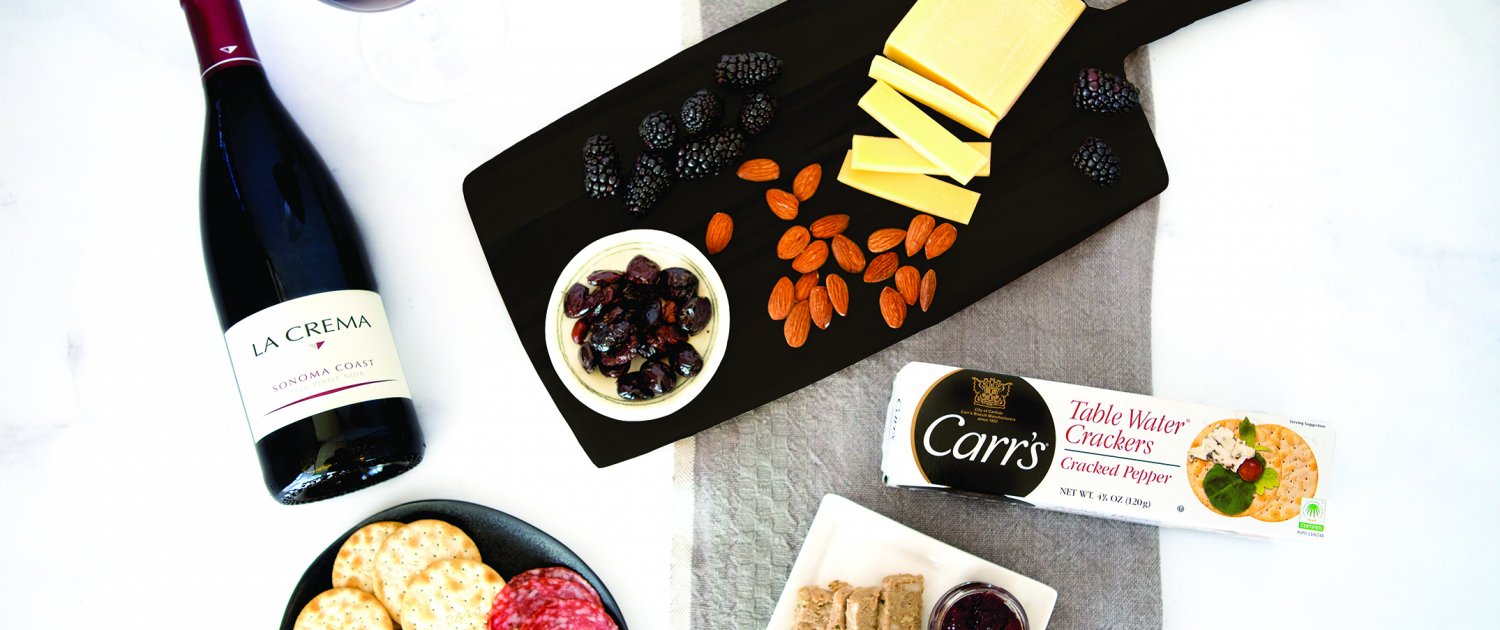
Sonoma Coast Pinot Noir
Bright and Silky
Washed rind cheeses often have an earthy or nutty tone to them, especially those from cool climates. This characteristic means that they work very well with the woodsy undercurrents frequently found in Pinot Noir. Likewise, the rustic notes of salumi (or charcuterie, as the French would call it), duck rillettes and patés also meld nicely with Pinot Noir. Additionally, Pinot’s bright acidity revives the palate after tastes of these unctuous foods. Keep experimenting by adding some dried, dark berries to match up with the Pinot Noir’s fruit flavors, or contrast the grape’s silky texture with some crunchy, roasted almonds. Like with salted nuts, cured olives will work in compelling contrast to the Pinot’s silky fruit, “cleaning up” the palate feel in a way that almost mimics acidity.
Pair with:
- Gruyère or washed rind soft cheese, such as Taleggio
- Carr’s® Table Water® Cracked Pepper Crackers
- Salumi, Duck Rillettes or Pâté
- Fresh Dark Cherries
- Blackberries
- Dry Roasted Almonds
- Dry Cured Black Olives
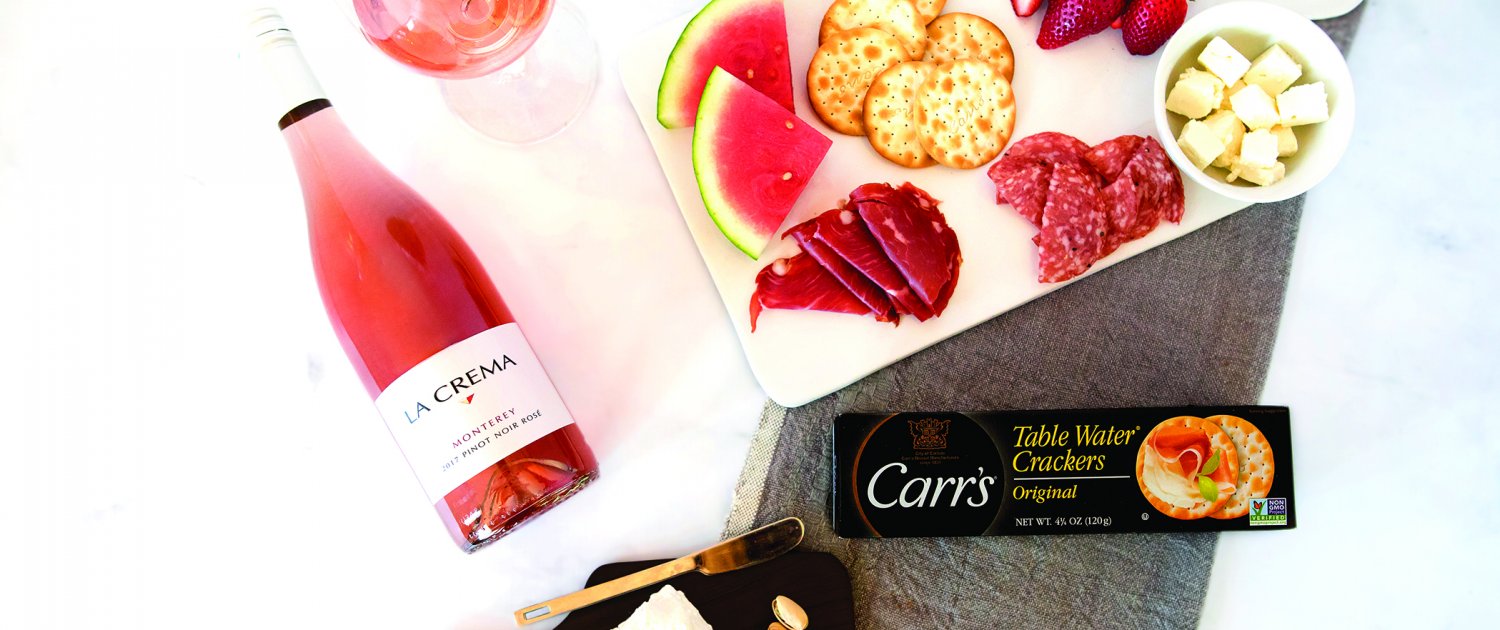
Monterey Rosé
Refreshing and Crisp
Rosé is an incredibly refreshing wine that is a unique stylistic cross-over between red and white wine styles. More than white and red, rosé’s light, summer-y flavors work very well fresh fruit, like strawberries and watermelon slices. Rosé’s youthfulness matches best with unaged and short-aged cheeses, and its crispness blends exceptionally well with the high acidity of goat milk cheeses. Pleasant base note contrasts can be found by adding the saltiness of salumi or the crunch of sweeter nuts, like pistachios.
Pair with:
- Chèvre or Feta Cheese
- Carr’s® Table Water® Original Crackers
- Salumi
- Fresh Watermelon or Strawberry
- Pistachios
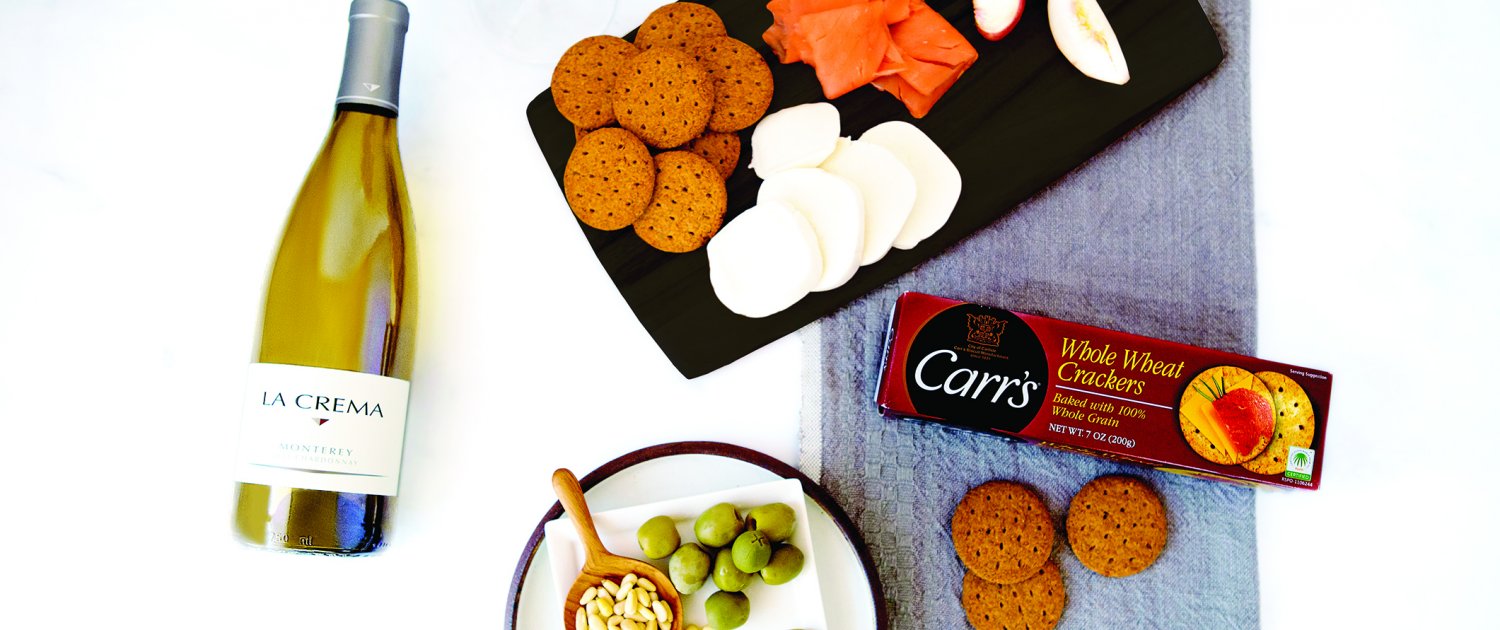
Monterey Chardonnay
Exotic and Juicy
The fruit profile of Monterey Chardonnay leans to the exotic, allowing it to mesh well with lower acid fruits like luscious white peaches. Its juicy, supple mouthfeel lends itself to unaged soft cheeses with lower acidity (i.e. cow’s milk cheeses), like fresh mozzarella, and the ultimately gooey cheese, mozzarella di bufala, made from buffalo milk. The addition of Carr’s Whole Wheat Crackers provides texture while keeping a consistent palate flavor with the sweetness of whole wheat. The Monterey Chardonnay also mates well with dry cured smoked salmon; the sumptuousness of the salmon flesh matches the wine’s palate while the saltiness contrasts the dramatic fruit flavors. Add in some crisply green, Castelvetrano olives for salty and crunchy contrast.
Pair with:
- Fresh Mozzarella Cheese
- Carr’s® Whole Wheat Crackers
- Dry Cured Smoked Salmon
- Fresh White Peach
- Toasted Pine Nuts
- Castelvetrano Olives
Monterey Pinot Noir
Deep and Earthy
The deep richness of La Crema Monterey Pinot Noir calls for similarly intense flavors. Optimal cheese pairings come from the aged cheese category: Gouda and Comté are excellent companions. These very long-aged versions of these cheeses often come with a fun crunchiness that can be a nice contrast to the wine’s mouthcoating texture. This Pinot Noir’s earthy character blends well with savory meats like rillettes, paté and charcuterie. The vinous flavors of black plums work naturally with slices of fresh dark plums. Dry cured black olives offer a creamy texture like the wine’s then deliver contrast to the vivid fruit in their salty kick. For a salty complement that adds textural verve, try munching on dry roasted almonds.
Pair with:
- Comté or Aged Gouda Cheese
- Carr’s® Rosemary Crackers
- Salumi, Duck Rillettes or Pâté
- Fresh Dark Plums
- Dry Roasted Almonds
- Dry Cured Black Olives
Monterey Pinot Gris
Fruity and bright
Pinot Gris is one of the most cheese-friendly wines around. It’s relatively reserved in fruit flavors, sees little to no new oak aging (keeping the wine focused on fresh fruit flavors) and feels medium in body. It’s the Goldilocks wine of cheese! The La Crema Monterey Pinot Gris has reserved fruit flavors that allow it to work well with both savory, crumbly cheeses like Manchego and creamy, smoothly textured cheeses like Muenster. The sweet-and-salty character of thinly sliced prosciutto works well as an accompaniment for the equally intense Manchego. Fresh nectarines will intensify the youthful fruit character of the wine when layered on the lighter-flavored Muenster. Change up the palate consistency with the crunch of Carr’s Table Water Original Crackers or the “flesh” of pistachio nuts.
Pair with:
- Manchego or Muenster Cheese
- Carr’s® Table Water® Original Crackers
- Prosciutto
- Fresh Nectarine
- Pistachios
Serving Tips
- When hosting a gathering, provide two ounces of cheese per person
- Cheese should be served at room temperature to avoid muting the flavor and texture
- Offer a variety of texture and cheese from different animal sources to keep it exciting
- Label the cheeses—get creative and write your own or recycle the store label
- Vary the accompaniments – fresh and dried fruit, nuts, honey – to stimulate your palate as well as your eyes
- Serve both fresh bread and crackers for texture variety

